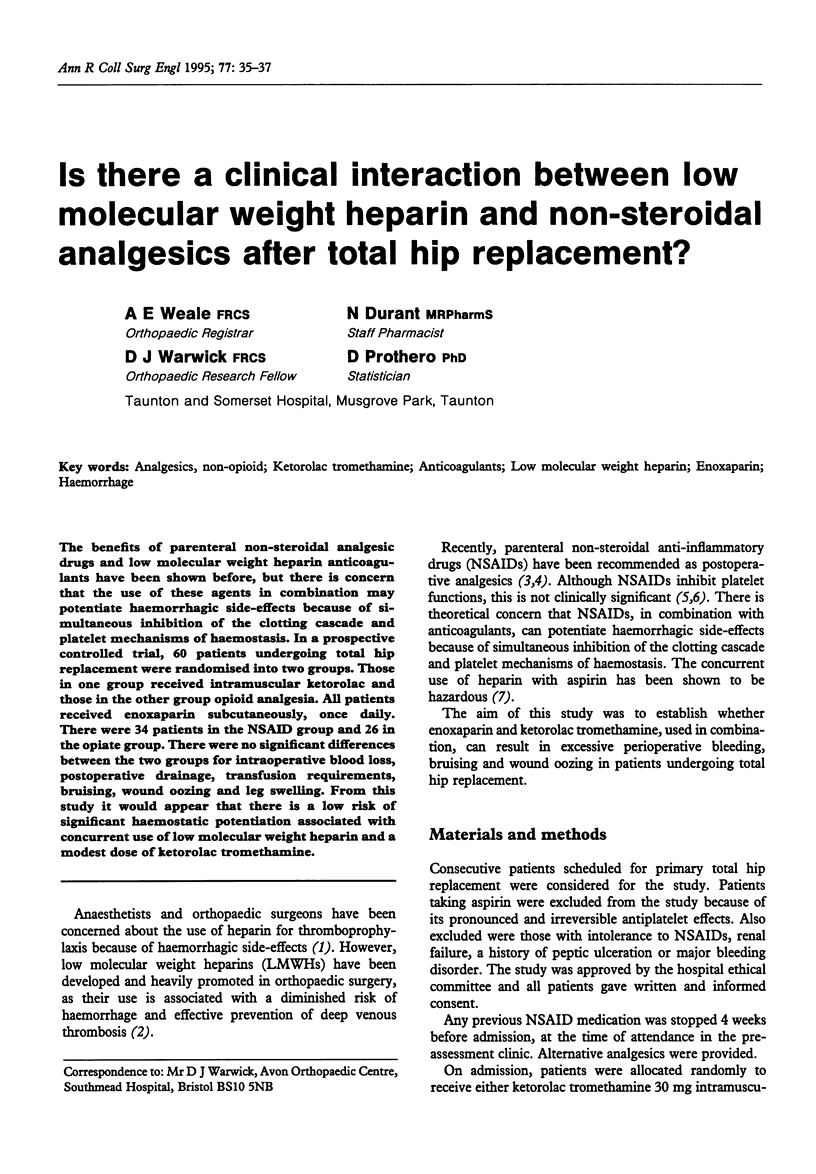Abstract
The benefits of parenteral non-steroidal analgesic drugs and low molecular weight heparin anticoagulants have been shown before, but there is concern that the use of these agents in combination may potentiate haemorrhagic side-effects because of simultaneous inhibition of the clotting cascade and platelet mechanisms of haemostasis. In a prospective controlled trial, 60 patients undergoing total hip replacement were randomised into two groups. Those in one group received intramuscular ketorolac and those in the other group opioid analgesia. All patients received enoxaparin subcutaneously, once daily. There were 34 patients in the NSAID group and 26 in the opiate group. There were no significant differences between the two groups for intraoperative blood loss, postoperative drainage, transfusion requirements, bruising, wound oozing and leg swelling. From this study it would appear that there is a low risk of significant haemostatic potentiation associated with concurrent use of low molecular weight heparin and a modest dose of ketorolac tromethamine.
Full text
PDF


Selected References
These references are in PubMed. This may not be the complete list of references from this article.
- Amrein P. C., Ellman L., Harris W. H. Aspirin-induced prolongation of bleeding time and perioperative blood loss. JAMA. 1981 May 8;245(18):1825–1828. [PubMed] [Google Scholar]
- Buchanan J. M., Baldasera J., Poole P. H., Halshaw J., Dallard J. K. Postoperative pain relief; a new approach: narcotics compared with non-steroidal anti-inflammatory drugs. Ann R Coll Surg Engl. 1988 Sep;70(5):332–335. [PMC free article] [PubMed] [Google Scholar]
- Collins R., Scrimgeour A., Yusuf S., Peto R. Reduction in fatal pulmonary embolism and venous thrombosis by perioperative administration of subcutaneous heparin. Overview of results of randomized trials in general, orthopedic, and urologic surgery. N Engl J Med. 1988 May 5;318(18):1162–1173. doi: 10.1056/NEJM198805053181805. [DOI] [PubMed] [Google Scholar]
- Hodsman N. B., Burns J., Blyth A., Kenny G. N., McArdle C. S., Rotman H. The morphine sparing effects of diclofenac sodium following abdominal surgery. Anaesthesia. 1987 Sep;42(9):1005–1008. doi: 10.1111/j.1365-2044.1987.tb05377.x. [DOI] [PubMed] [Google Scholar]
- Laverick M. D., Croal S. A., Mollan R. A. Orthopaedic surgeons and thromboprophylaxis. BMJ. 1991 Sep 7;303(6802):549–550. doi: 10.1136/bmj.303.6802.549. [DOI] [PMC free article] [PubMed] [Google Scholar]
- Levine M. N., Hirsh J., Gent M., Turpie A. G., Leclerc J., Powers P. J., Jay R. M., Neemeh J. Prevention of deep vein thrombosis after elective hip surgery. A randomized trial comparing low molecular weight heparin with standard unfractionated heparin. Ann Intern Med. 1991 Apr 1;114(7):545–551. doi: 10.7326/0003-4819-114-7-545. [DOI] [PubMed] [Google Scholar]
- Meade E. A., Smith W. L., DeWitt D. L. Differential inhibition of prostaglandin endoperoxide synthase (cyclooxygenase) isozymes by aspirin and other non-steroidal anti-inflammatory drugs. J Biol Chem. 1993 Mar 25;268(9):6610–6614. [PubMed] [Google Scholar]
- Murphy D. F. NSAIDs and postoperative pain. BMJ. 1993 Jun 5;306(6891):1493–1494. doi: 10.1136/bmj.306.6891.1493. [DOI] [PMC free article] [PubMed] [Google Scholar]
- Small R. E., Johnson S. M. Consideration of platelet effects in the selection of an anti-inflammatory agent. Clin Pharm. 1987 Oct;6(10):756–757. [PubMed] [Google Scholar]
- Spowart K., Greer I. A., McLaren M., Lloyd J., Bullingham R. E., Forbes C. D. Haemostatic effects of ketorolac with and without concomitant heparin in normal volunteers. Thromb Haemost. 1988 Dec 22;60(3):382–386. [PubMed] [Google Scholar]
- Yett H. S., Skillman J. J., Salzman E. W. The hazards of aspirin plus heparin. N Engl J Med. 1978 May 11;298(19):1092–1092. doi: 10.1056/nejm197805112981919. [DOI] [PubMed] [Google Scholar]


